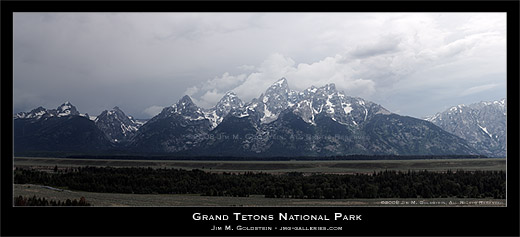One of the more exhillerating aspects of being in the field is when you’re traveling at just the right pace to stay ahead of an approaching storm. Such was the case as I traveled through Utah and Wyoming last week. By the time I arrived at the Grand Teton National Park the storm that was on my tail had started to roll through. Once I settled on a location to photograph the Tetons I was able to enjoy the show.
It’s one thing to snap a photo of a dramatic landscape such as this, but it is another to see and feel the wrath of Mother Nature in the process. Gusts of wind, rain and varying intensity of light made for a great show and a challenging capture. Although the light was rather muted at this particular moment later in the evening there was quite a light show. Photos of that will follow in the coming days.
This was the second largest panoramic I created on my short trip. The original size is 16,000 x 7000px, enough resolution to produce a 300 DPI print at 4 1/2 x 2 feet. Photos like this remind me it is time to upgrade my printer. Fear not the large version linked above is only 1400px wide. Enjoy.
[tags]Grand Teton National Park, mountain, NPS, landscape, photography, panoramic[/tags]


so going back to your previous post about photo manipulation and whether or not we can believe our eyes. . . would you consider a panorama that’s been stitched together to be “trustworthy”?. . .
‘cuz in some ways a stitched panorama is similar to an HDR shot (as in they both consist of multiple photos taken over a span of time and then manipulated via software to become one single photo), and in the comments you sounded kind of incredulous that HDR is making its way into photojournalism. . .
personally if someone took a series of panorama shots, noticed that a bird or a car was on a border and would get cut in half by the software, photoshopped it out, stitched the panorama together, and sold it to some magazine, it wouldn’t make me trust the magazine (or photographer) any less. ..
@bloopy great comment and question. In both cases HDR or panoramics tackle a limitation of ones camera. HDR addresses limited dynamic range of the sensor and panoramics address limitations of sensor size and/or optical field of view.
–
My comment about HDR in photojournalism was that of surprise not of disagreement of its use necessarily. I’ve not heard that either HDR and panoramic photography are accepted in photojournalism circles. Depending on ones personal perspective it would be easy to side one way or the other. Although I may not be fond of one technique versus the other, in this instance I have no opinion as to their appropriateness in the circle of photojournalism. I look forward actually to learning how photojournalists interpret the appropriateness of these techniques.
–
One thing to keep in mind… I did not claim that panoramic photography (especially mine) is photojournalism and to date I’ve not seen panoramics passed off as photojournalistic work. My personal philosophy is to create panoramics that represent the actual scene, but make no mistake there is always a certain degree of artistic license in how the image is treated. Adjustments may be made in relation to contrast, saturation, conversion to B&W, etc. For some that may cross the line and for others it may not. It’s a matter of personal taste. Personally I don’t feel I do anything more to my photographs that a more classic landscape photographer would do in a film darkroom. If I do I’ll do my best to state so.
–
To the question of trust… per my earlier clarifications if what I’m striving for is fine art through my landscape work versus photojournalism is trust still a relevant concern? It could be if you’re looking for a strict interpretation of the scene. Whether or not a bird is removed in blending multiple images together is less a concern versus a more substantial alteration of the landscape that is represented behind it. After all the bird is not the focus or subject of the scene. When it comes to trust of a magazine publishing such work, ones trust will need to be tempered based on the magazine in question. I’m not sure if National Geographic to date has published a digital panoramic photo but I also know they’ve published edited film photographs while another publication such as Popular Photography might not have any qualms in publishing such photography. I think it is fair to say that people reset their expectations based on the periodical or news source they read.
–
Thanks for the thought provoking question.
Often when the light is not right we pass up opportunities. You took advantage of a situation and expressed it well with text and a dynamic image, different than what is stereotypically shot of the Tetons.
Lovely panoramic shot.
Interesting comments; I’ve always felt that photographic creation/interpretation is a double-edged sword. Either you’re of the opinion that the image cannot and should not be manipulated in any way (strict photojournalism) or that photography is an art medium whose interpretation is very subjective and, as an art medium, it is acceptable to “manipulate” the image to challenge the viewer’s perception. The line is blurred somewhat these days as it has become more acceptable to “perfect” or “fix” an image.
Great blog, btw.
Sick photo, Jim. Very epic.
@Ken Thanks for the compliment. It is indeed amazing what “less than ideal” conditions can provide.
@Hawaii Photographer Thanks for the comment. I think your interpretation of photojournalism vs the broader freedom of “art of photography” is a fair interpretation. Different groups can get a little more picky about what is and isn’t allowed depending on the genre of work.
@Bryan Villarin Thanks!